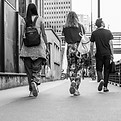
To help close the racial gap in tech, we designed an inclusive social networking app that encourages deeper connections and in-person support for emerging design professionals.
Team
I worked as the UX Lead and PM support in a team of 4, consisting of a researcher, content strategist, and project manager
Tools
Figma + Figjam,
Adobe CC
ChatGPT, otter.ai
Transcribe.ai
Zoom
View Prototype
Context
Problem: For creatives in tech, there is a significant racial gap
< 5% Black and > 50% White.
Goal: Develop a social networking app that Bridgegood creatives who want to get into tech can connect, meet, and succeed in their career goals.
The Research Process
Major Career-Building Frustrations
1
1 on 1 Interviews
9 women & 6 men
15 Interviews
...with BIPOC students, new grads, and career pivoters. We dove into personal stories and struggles to understand the real needs and looked for common themes in-person and on Zoom.
2
Surveys
25 Written Responses
Google Form Surveys
...to interview participants to clarify pain points. We asked about types of professional connections,
education and career struggles,
existing platforms used, needs for career development
3
Competitive Analysis
Apps: Education, social networking, mental health
We researched the main features and cross checked that with what our users say about how they use other platforms. In addition, reviewed heuristics to see what's really usable.
Discovery
76% Need Deep Connections
Emerging creatives of color face challenges finding meaningful connections with peers and mentors, leading to feelings of loneliness, disconnect, and confidence to pursure opportunities.
Interviews revealed what's important...
Insights

Community = Family
Community and mentors are there for..."definitely career help but then also emotional support where you encourage others to keep going and when someone's down you pick them up."
Student
East Asian, Male

Race & Belonging
"I think a lot of it was in my head, because I saw everybody in charge was white and male... It pushed me to fight and then I got tired of fighting."
Career Pivoter
Southeast Asian, Female

Trusted Connections
"You don't have to feel scared, because, you know, you're going to be accepted. If you feel like you're in a bubble it just makes you more or less likely to reach out to others, so in the end less opportunities."
Student
Black, Female
The Persona

A professor tells Renee about LUNR

How We Addressed Pain Points
Before LUNR
No mentor
Doesn't feel connection through race/culture
Social Anxiety
Not part of a community she can trust
Feeling Alone
Searching for people who look like me
After LUNR
Access to mentors
With similar background and race
In-App AI Help
For messaging and maintaining relationships
Part of a Community
Higher comfort level being around similar people
Design Challenges
Considerations during initial prototyping
1. Welcome message: how do we show our mission here?
2. Onboarding can't be too wordy, split up screens?
3. 'Cloud' bubbles or use typical shapes for consistency?
4. Statement - build trust and set the tone
5. Keep the navbar minimal & intuitive
6. What categories for filters?
7. Make it easy to message others from profile
8. How can AI help with social anxiety?

1
2
3
4
5
6
7
8
User Testing Insights
User Comment
Icons are unclear what action they represent
Didn't know what to do to move forward during onboarding
The screens feel visually cluttered, its hard to focus and feeling overwhelmed
Two chat icons on the screen: what's the difference? Which one do I use to message someone?
I can't tell which menu I'm on in the navigation
Our Solution
Changed stylized icons to standard icons
Animate the screen to signal swiping & add visual arrow with "swipe"
Reduce number of options to select and organize the buttons into an orderly 'cloud'
Keep one chat icon and move to central position, add a color to signal an action
Re-check accessibility and add prominent color behind icon to show that it's selected
Final Prototype Revisions
1. Splash screen directly introduces the app's main goal
2. Onboarding: each statement shows on one screen, building up user journey & expectations
3. Buttons changed to standard shape and organized in a staggered grid
4. Statement that you are not alone and welcome to the community
5. Reduced nav options to simplify menu
6. Only kept minimal filters to keep it quick and simple
7. Chat icon centered on profile photo as a clear CTA to chat and connect
8. Agentic AI prompt help users start conversations in a professional, friendly tone
9. Intentional colors used for action buttons to show urgency
10. Badge messages for continuous user encouragement

1
2
3
4
5
6
7
8
10
9
Galaxy Theme
Our team collaborated on the app’s theme, color scheme, and branding, aligning on the idea that meaningful connections—like finding a mentor or ally—are meant to be. We chose colors that complemented Bridgegood’s brand and a name that felt simple, friendly, and timeless.

Logo Design

Concept Board

Visual Design
Potential Benefits
User Benefits
Business Value
Trusted & Verified Users
All members verified by Bridgegood staff
Reduced Social Anxiety
AI supported chat & encouragement
Access to Safe Community
Grow with Like-Minded Individuals
Peer-to-Peer Support
Make In-Person Connections
Expand Outreach by 50%
To Bridgegood alumni and connections
Foster Monetary Growth by 20%
Connections to future donors
Discover more Supporters
Trustworthy partners
Maintain 50% more Connections
Keep in touch with the Bridgegood community
Closing Thoughts

While the project wasn’t launched, its potential to strengthen Bridgegood’s community is clear. By keeping alumni and mentors connected, it could sustain long-term support, shared opportunities, and a culture of giving back. It also offers strategic value—boosting engagement, retention, and donor interest, making it a meaningful investment in community and purpose.

In Collaboration with:

